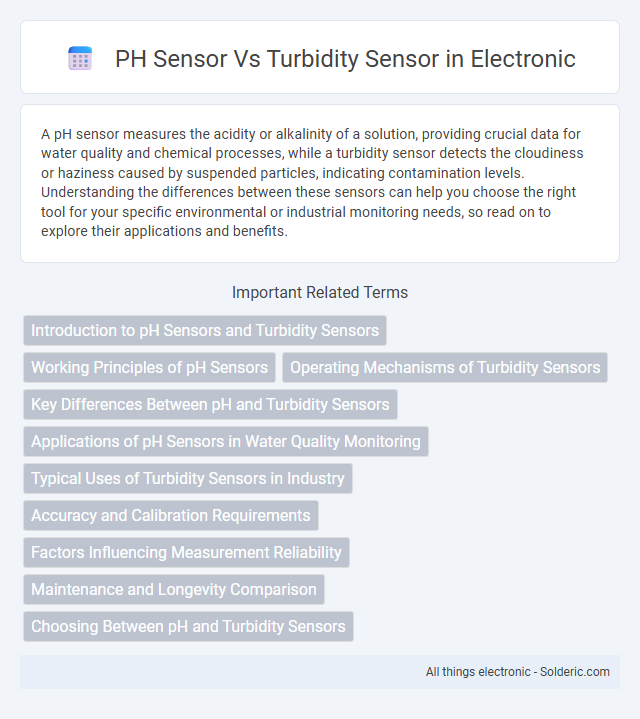A pH sensor measures the acidity or alkalinity of a solution, providing crucial data for water quality and chemical processes, while a turbidity sensor detects the cloudiness or haziness caused by suspended particles, indicating contamination levels. Understanding the differences between these sensors can help you choose the right tool for your specific environmental or industrial monitoring needs, so read on to explore their applications and benefits.
Comparison Table
| Feature | pH Sensor | Turbidity Sensor |
|---|---|---|
| Measurement | Hydrogen ion concentration (acidic or basic level) | Water clarity by measuring suspended solids |
| Unit | pH scale (0-14) | Nephelometric Turbidity Units (NTU) |
| Application | Water quality, chemical processes, agriculture | Water treatment, environmental monitoring |
| Sensor Type | Glass electrode or ISFET-based | Optical sensor with light source and detector |
| Output Signal | Voltage correlated to pH level | Light intensity or voltage indicating turbidity |
| Calibration | Standard buffer solutions (pH 4, 7, 10) | Certified turbidity standards |
| Sensitivity | Highly sensitive to hydrogen ion changes | Detects suspended particles as low as 0.1 NTU |
| Cost | Moderate | Moderate to high |
| Maintenance | Periodic calibration and electrode cleaning | Cleaning optical components, calibration |
Introduction to pH Sensors and Turbidity Sensors
pH sensors measure the hydrogen ion concentration in a solution, providing critical data about its acidity or alkalinity, essential for water quality monitoring and chemical processing. Turbidity sensors detect the cloudiness or haziness caused by suspended particles in a liquid, crucial for assessing water clarity and contamination levels. Your choice between these sensors depends on whether monitoring chemical properties or particulate presence is more relevant to your application.
Working Principles of pH Sensors
pH sensors operate based on the measurement of hydrogen ion activity in a solution, utilizing a glass electrode sensitive to changes in ion concentration. The sensor generates a voltage proportional to the pH level, which is then converted into a readable value indicating the acidity or alkalinity of the liquid. This electrochemical principle allows precise monitoring of water quality, making pH sensors essential in environmental and industrial applications compared to turbidity sensors that measure suspended particles.
Operating Mechanisms of Turbidity Sensors
Turbidity sensors operate by measuring the intensity of light scattered by suspended particles in a liquid, typically using nephelometric or turbidimetric methods. These sensors emit a light source, often infrared or LED, and detect the scattered or transmitted light to determine turbidity levels, which correlate with water quality and clarity. Unlike pH sensors that measure hydrogen ion concentration to assess acidity or alkalinity, turbidity sensors provide critical data on particulate presence in water systems.
Key Differences Between pH and Turbidity Sensors
pH sensors measure the hydrogen ion concentration in a solution, providing crucial data on acidity or alkalinity, while turbidity sensors detect the cloudiness or haziness caused by suspended particles in water. pH sensors typically use glass electrodes and require regular calibration for accurate readings, whereas turbidity sensors often rely on optical methods such as nephelometry to quantify particle concentration. The key differences lie in their measurement focus--chemical ion concentration for pH versus physical light scattering for turbidity--and their applications in water quality monitoring and environmental analysis.
Applications of pH Sensors in Water Quality Monitoring
pH sensors play a crucial role in water quality monitoring by accurately measuring the acidity or alkalinity of water, which directly affects aquatic life and ecosystem health. These sensors are widely used in drinking water treatment, wastewater management, and environmental monitoring to ensure safe and compliant water conditions. Your ability to track pH levels in real-time helps identify contamination sources and maintain optimal water quality for various industrial, environmental, and public health applications.
Typical Uses of Turbidity Sensors in Industry
Turbidity sensors are widely used in water treatment plants to monitor and control the clarity of water, ensuring compliance with regulatory standards. In the food and beverage industry, these sensors help maintain product quality by detecting particulate contamination in liquids. Industrial applications also include monitoring effluents and wastewater to prevent environmental pollution and optimize filtration processes.
Accuracy and Calibration Requirements
pH sensors provide precise measurements of hydrogen ion concentration with high accuracy but require frequent calibration using standard buffer solutions to maintain their reliability. Turbidity sensors measure the cloudiness or suspended solids in a liquid, generally offering good accuracy but can be influenced by particle size and color, necessitating regular calibration with reference standards. Your choice depends on the specific parameter critical to your application and the sensor's calibration regimen to ensure consistent performance.
Factors Influencing Measurement Reliability
Measurement reliability in pH sensors is influenced by factors such as electrode condition, temperature variations, and calibration frequency, which directly impact the accuracy of hydrogen ion concentration readings. Turbidity sensors' reliability depends on particle size, light scattering interference, and sensor fouling, affecting the precision of suspended solids detection in water. Ensuring proper maintenance and environmental control enhances the consistency of your pH and turbidity sensor measurements.
Maintenance and Longevity Comparison
pH sensors require regular calibration and electrode replacement to maintain accuracy, as their glass electrodes can degrade over time due to chemical exposure. Turbidity sensors generally need less frequent maintenance, with periodic cleaning of the optical components to prevent fouling and maintain reliable light scattering measurements. In terms of longevity, turbidity sensors often outlast pH sensors in harsh environments, but both depend heavily on proper care and operating conditions.
Choosing Between pH and Turbidity Sensors
Selecting between pH and turbidity sensors depends on the specific water quality parameter needing measurement: pH sensors monitor hydrogen ion concentration indicating acidity or alkalinity, essential for chemical balance and biological processes. Turbidity sensors measure suspended particles affecting water clarity, crucial for assessing sediment levels and potential contaminants. Understanding the application's focus--chemical composition versus particulate matter--guides the choice toward the appropriate sensor technology.
pH sensor vs turbidity sensor Infographic

 solderic.com
solderic.com